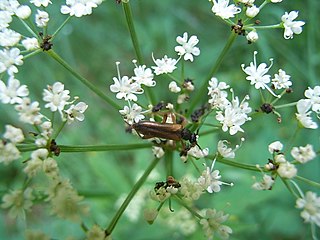Related Research Articles

Genus is a taxonomic rank above species and below family as used in the biological classification of living and fossil organisms as well as viruses. In binomial nomenclature, the genus name forms the first part of the binomial species name for each species within the genus.

Charales is an order of freshwater green algae in the division Charophyta, class Charophyceae, commonly known as stoneworts. Depending on the treatment of the genus Nitellopsis, living (extant) species are placed into either one family (Characeae) or two. Further families are used for fossil members of the order. Linnaeus established the genus Chara in 1753.

Lepturinae, the lepturine beetles, is a subfamily of the longhorn beetle family (Cerambycidae), containing about 150 genera worldwide. This lineage is most diverse in the Northern Hemisphere. Until recently the subfamily Necydalinae was included within the lepturines, but this has been recently recognized as a separate subfamily. Nine tribes are usually recognized today, with a tenth, Caraphiini, created in 2016. A few genera are of uncertain placement within the subfamily.
Brachypareion is an extinct genus of prehistoric marine ray-finned fish that lived during the Pennsylvanian epoch. It contains a single species, B. insperatum, known from the Saur Mountains of Kazakhstan. It is placed in the paraphyletic group Palaeonisciformes.

Trigonoptila latimarginaria is a moth of the family Geometridae first described by John Henry Leech in 1891. It is found in Japan, the Korean Peninsula, Taiwan and China.
Encyclops caerulea is a species of beetle in the family Cerambycidae. It was described by Say in 1826.
Encyclops californica is a species of beetle in the family Cerambycidae. It was described by Van Dyke in 1920.
Egesina fujiwarai is a species of beetle in the family Cerambycidae. It was described by Toyoshima in 1999.

Tmesisternus adspersarius is a species of beetle in the family Cerambycidae. This species was described by Stephan von Breuning in 1939 as part of his extensive work on the systematics of Cerambycidae beetles, particularly within the Tmesisternini tribe, highlighting its placement within the larger framework of longhorn beetle diversity.

The Interim Register of Marine and Nonmarine Genera (IRMNG) is a taxonomic database which attempts to cover published genus names for all domains of life, from 1758 in zoology up to the present, arranged in a single, internally consistent taxonomic hierarchy, for the benefit of Biodiversity Informatics initiatives plus general users of biodiversity (taxonomic) information. In addition to containing just over 500,000 published genus name instances as at May 2023, the database holds over 1.7 million species names, although this component of the data is not maintained in as current or complete state as the genus-level holdings. IRMNG can be queried online for access to the latest version of the dataset and is also made available as periodic snapshots or data dumps for import/upload into other systems as desired. The database was commenced in 2006 at the then CSIRO Division of Marine and Atmospheric Research in Australia and, since 2016, has been hosted at the Flanders Marine Institute (VLIZ) in Belgium.
Compsosaurus is an extinct genus of phytosaur, a crocodile-like reptile that lived during the Triassic. Its fossils have been found in North Carolina. The type species, Compsosaurus priscus, was named by American paleontologist Joseph Leidy in 1856, although other sources say 1857. Compsosaurus may have been the same animal as the related Belodon.

Alosterna is a genus of beetles belonging to the family Cerambycidae.
Hylochares is a genus of beetles belonging to the family Eucnemidae.

Paracorymbia is a genus of beetles belonging to the family Cerambycidae.
Encyclops concinna is a species of beetle in the family Cerambycidae. It was described by Holzschuh in 1991.

Babesiidae is a family of protists belonging to the order Piroplasmida.
Ptyssalges is a monotypic genus of mites belonging to the monotypic family Ptyssalgidae. The only species is Ptyssalges major.
Colinatys is a monotypic genus of gastropods belonging to the monotypic family Colinatydidae. The only species is Colinatys alayoi.
Lestonia is a genus of true bugs belonging to the monotypic family Lestoniidae.

Coptocercus crucigerus is a species of beetle in the family Cerambycidae, first described by Frederick William Hope in 1842 as Stenochorus cruciger, from a specimen collected in Port Essington (Darwin). In 1929, Herbert James Carter assigned the species to the genus Coptocercus, and also synonymised it with Phoracantha politaPascoe, 1863.
References
- ↑ Bezark, Larry G. A Photographic Catalog of the Cerambycidae of the World Archived 2013-08-27 at the Wayback Machine . Retrieved on 22 May 2012.
- ↑ "IRMNG - Encyclops Newman, 1838". www.irmng.org. Retrieved 2019-07-27.